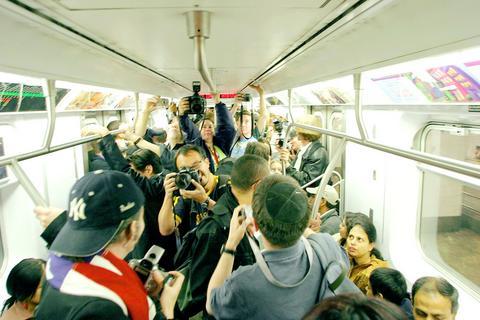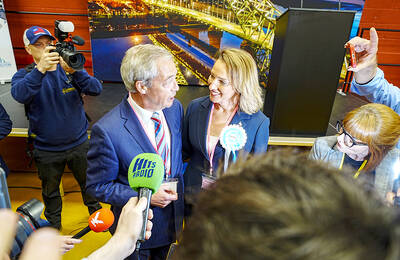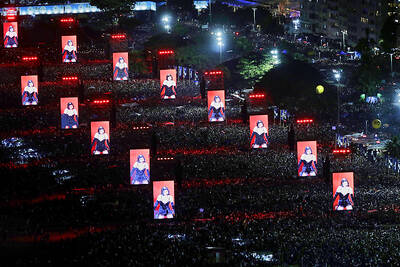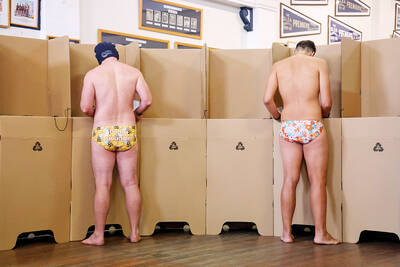At a protest by photographers, you see things like a guy taking pictures of a guy taking pictures of a few more guys taking pictures of each other. There was such a protest on Sunday, but it might take hundreds of pages to describe it, given all the pictures that were taken, each one worth at least a thousand words.
The photographers -- about 100 of them -- gathered to express their outrage at the Metropolitan Transportation Authority's proposed ban on taking pictures in the subway system.

PHOTO: NY TIMES NEWS SERVICE
Meeting at Grand Central Terminal, they rode the trains for upward of an hour, shutters clicking, flashes popping, in a filmed rebuke to the idea that photography is somehow a national security threat.
"The point is really to make everyday people wake up and realize that photographers are not terrorists," said Joe Anastasio, who organized the event. "In the last few years, photographers near anything vaguely important have been getting harassed."
Anastasio went on to tell the story of a friend who took his wife's picture near the Whitestone Bridge, only to be called in for questioning by the police. He told another of a man caught snapping pictures at a Metro-North station who was interrogated for nearly two hours by authorities at the scene.
"The paranoia," he said, "has gone a little too far."
The transit authority's proposal, posted on its Web site, says the agency is planning to adopt "a general prohibition against photography and videotaping in the system." The agency is soliciting public comment on the ban and plans to vote on the proposal in the next few months.
"It's a security measure," said a spokeswoman for the agency, Deirdre Parker. "It was suggested by the NYPD."
Anastasio and his fellow photographers said it was ridiculous that pictures of the subway might somehow make the trains unsafe. After all, they said, there are thousands of subway photographs already on the Internet.
"The subway is so well documented that what's the point?" asked Jean Miele, a fine art and commercial photographer. "This sort of thing makes us less free, not safer."
Infuriated that his photographic rights might in fact be curtailed, Anastasio sent messages to several friends, asking them to show up on Sunday to photograph the subway. They did -- with Nikons, Leicas, Canons and such.
There were an US$8,000 digital job and a cheap mini that showed a nudie picture through its viewfinder.
When a downtown No. 6 train arrived, the photographers began to cheer. They boarded in a herd and held their cameras up, taking pictures of other hands holding cameras up.
At the 14th Street station, they split into two groups, stood against the walls and photographed each other across a corridor.
There was a tense moment when the crowd decided it would photograph a transit police dispatch station at 14th Street. A startled officer came out and suggested that they leave.
"You didn't say `Cheese!"' one of the cheekier photographers said.
Many of the photographers said they planned to post their pictures on the Internet -- Jared Skolnick, for example, who takes pictures of the subway on his cellphone and then displays them online.
"I've learned that so many crazy things can happen on the subway," said Skolnick, who paused and then added, "including this."

Kehinde Sanni spends his days smoothing out dents and repainting scratched bumpers in a modest autobody shop in Lagos. He has never left Nigeria, yet he speaks glowingly of Burkina Faso military leader Ibrahim Traore. “Nigeria needs someone like Ibrahim Traore of Burkina Faso. He is doing well for his country,” Sanni said. His admiration is shaped by a steady stream of viral videos, memes and social media posts — many misleading or outright false — portraying Traore as a fearless reformer who defied Western powers and reclaimed his country’s dignity. The Burkinabe strongman swept into power following a coup in September 2022

‘FRAGMENTING’: British politics have for a long time been dominated by the Labor Party and the Tories, but polls suggest that Reform now poses a significant challenge Hard-right upstarts Reform UK snatched a parliamentary seat from British Prime Minister Keir Starmer’s Labor Party yesterday in local elections that dealt a blow to the UK’s two establishment parties. Reform, led by anti-immigrant firebrand Nigel Farage, won the by-election in Runcorn and Helsby in northwest England by just six votes, as it picked up gains in other localities, including one mayoralty. The group’s strong showing continues momentum it built up at last year’s general election and appears to confirm a trend that the UK is entering an era of multi-party politics. “For the movement, for the party it’s a very, very big

ENTERTAINMENT: Rio officials have a history of organizing massive concerts on Copacabana Beach, with Madonna’s show drawing about 1.6 million fans last year Lady Gaga on Saturday night gave a free concert in front of 2 million fans who poured onto Copacabana Beach in Rio de Janeiro for the biggest show of her career. “Tonight, we’re making history... Thank you for making history with me,” Lady Gaga told a screaming crowd. The Mother Monster, as she is known, started the show at about 10:10pm local time with her 2011 song Bloody Mary. Cries of joy rose from the tightly packed fans who sang and danced shoulder-to-shoulder on the vast stretch of sand. Concert organizers said 2.1 million people attended the show. Lady Gaga

SUPPORT: The Australian prime minister promised to back Kyiv against Russia’s invasion, saying: ‘That’s my government’s position. It was yesterday. It still is’ Left-leaning Australian Prime Minister Anthony Albanese yesterday basked in his landslide election win, promising a “disciplined, orderly” government to confront cost-of-living pain and tariff turmoil. People clapped as the 62-year-old and his fiancee, Jodie Haydon, who visited his old inner Sydney haunt, Cafe Italia, surrounded by a crowd of jostling photographers and journalists. Albanese’s Labor Party is on course to win at least 83 seats in the 150-member parliament, partial results showed. Opposition leader Peter Dutton’s conservative Liberal-National coalition had just 38 seats, and other parties 12. Another 17 seats were still in doubt. “We will be a disciplined, orderly